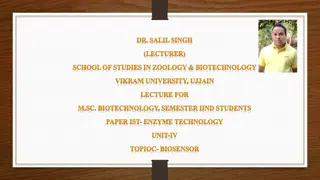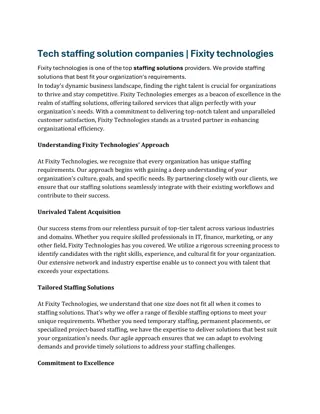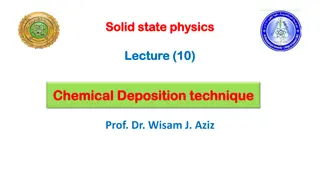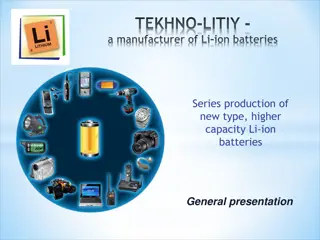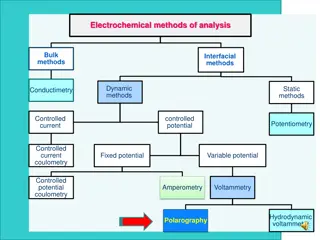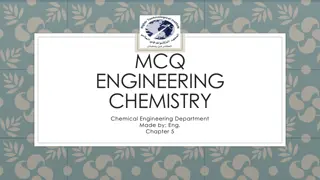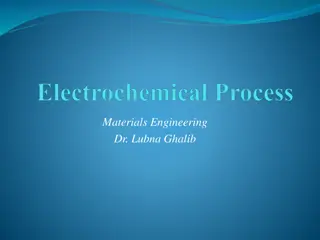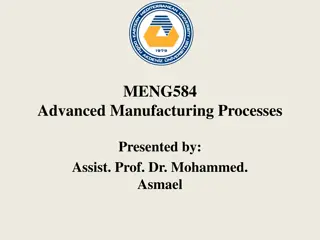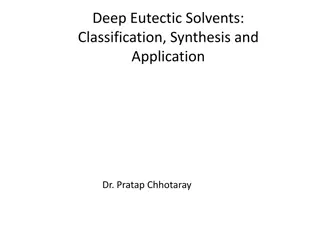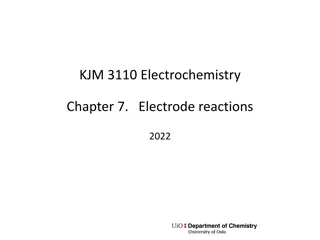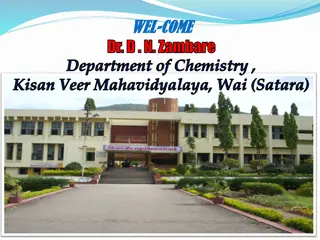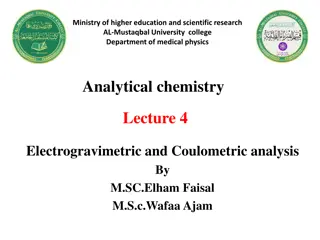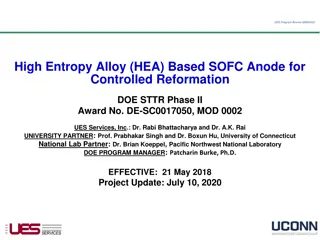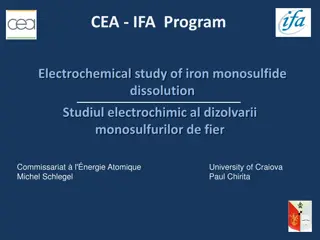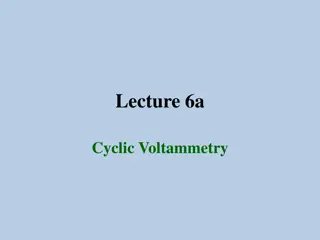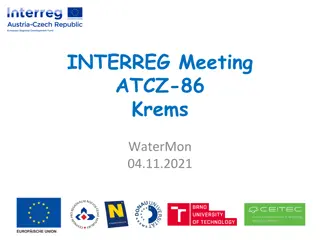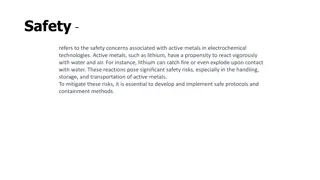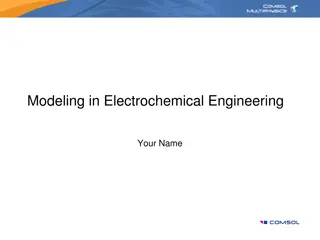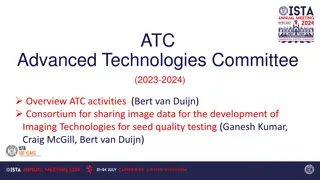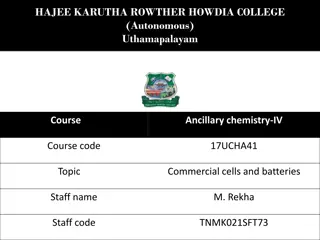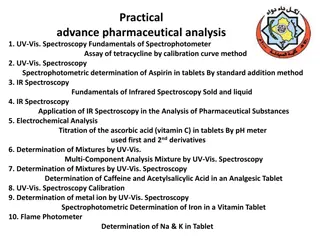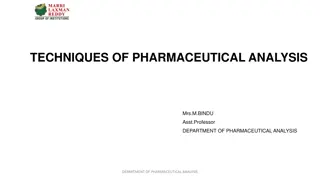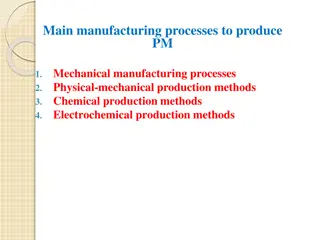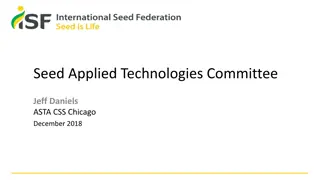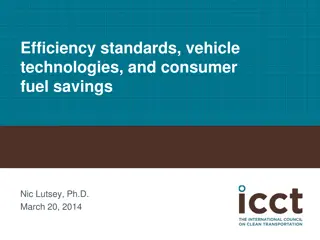Overview of Biosensors: Applications and Types
Biosensors are advanced analytical devices that convert biological responses into quantifiable signals, comprising bioreceptors and transducers. They play a crucial role in various fields, meeting specific requirements for accuracy, reproducibility, and ease of use. Different types of biosensors suc
9 views • 8 slides
Tech staffing solution companies | Fixity technologies 2024-2025
Fixity technologies is one of the top staffing solutions providers. We provide staffing solutions that best fit your organization's requirements. \nIn today's dynamic business landscape, finding the right talent is crucial for organizations to thrive and stay competitive. Fixity Technologies emerges
4 views • 2 slides
Chemical Deposition Techniques in Solid State Physics
Chemical deposition is a fabrication technique using different chemicals for reactions, allowing coatings to form successfully. Techniques include spray pyrolysis, electrochemical deposition, dip coating, and more. Spray pyrolysis, cost-effective and versatile, is used in various commercial processe
1 views • 25 slides
Evolution of Technologies: A Journey Through Revolutions
Explore the evolution of technologies through different revolutions - from the agricultural revolution to the emerging technologies of the future. Learn about the profound changes in economic relationships and technological conditions that have shaped human society. Discover the role of data, progra
0 views • 58 slides
Challenges and Considerations of Greenhouse Gas Removal Technologies
Greenhouse Gas Removal (GGR) technologies, such as Bioenergy with Carbon Capture and Storage (BECCS) and Direct Air Capture and Carbon Storage, present complex challenges and uncertainties. While nature-based solutions like forest restoration offer potential win-win scenarios, the risks associated w
1 views • 10 slides
Advancements in Li-ion Battery Technology by Tekhno-Litiy
Tekhno-Litiy, a prominent manufacturer of Li-ion batteries, introduces higher capacity batteries with exceptional advantages such as high energy density, no memory effect, low self-discharging, and fast charging. They excel in the production of second-generation Li-ion batteries based on nano-struct
0 views • 5 slides
Polarography in Electrochemical Analysis
Explore the realm of polarography, a type of voltammetry utilizing the dropping mercury electrode (DME) and mercury pool. Learn about classical polarographs, the Ilkovic equation, advantages and disadvantages of mercury drop electrodes, and how to minimize polarographic maxima in electrochemical ana
2 views • 23 slides
Gas Detector Alarms Market Future Prospects 2030
Global Gas Detector Alarms Market Breakdown by Type (Electrochemical sensors, Catalytic sensors, Infrared sensors, Photoionization sensors, Others) by Modality (Portable, Fixed) by End-Use Industry (Oil & Gas, Chemical & Petrochemical, Metal & Mining
1 views • 8 slides
Corrosion Prevention Methods in Chemical Engineering
Define oxidation, reduction, oxidizing agent, reducing agent, standard electrode potential, Nernst equation, and corrosion in the context of chemical engineering. Discuss different forms of corrosion, including uniform corrosion, galvanic corrosion, pitting corrosion, and stress corrosion. Explore m
1 views • 20 slides
Electrochemical Processes in Materials Engineering
Electrochemical processes play a crucial role in materials engineering, specifically in the context of corrosion. These processes involve both oxidation (anodic reaction) and reduction (cathodic reaction) reactions occurring simultaneously. Maintaining a balance between these reactions is essential
3 views • 22 slides
Advanced Hybrid Electrochemical Machining Processes
Hybrid electrochemical machining processes combine chemical dissolution and electrochemical dissolution mechanisms with mechanical or thermal assistance to achieve high material removal rates and improved surface quality. Techniques such as laser-assisted chemical etching and ultrasonic-assisted mac
1 views • 26 slides
Deep Eutectic Solvents: Classification, Synthesis, and Applications
Deep Eutectic Solvents (DES) are versatile solvents formed by mixing specific acids and bases. These solvents exhibit unique hydrogen bonding properties, resulting in a lower melting point compared to individual components. DES can be classified into hydrophobic and hydrophilic types, each with dist
3 views • 7 slides
Electrode Reactions in Electrochemistry
Exploring electrode reactions in electrochemistry involves delving into Faraday's law, coulometry, and the importance of sustainable electrode reactions. These concepts help us understand how the quantity of charge passed affects the production or consumption of substances in electrode reactions. As
4 views • 27 slides
Potentiometry and Electrochemical Cells
Electrochemical cells play a vital role in redox reactions, with potentiometry being a quantitative analysis method based on measuring potentials. These cells consist of two half-cells where reduction and oxidation take place, forming anode and cathode. Reference electrodes like calomel and Ag/AgCl
1 views • 9 slides
Electrochemistry: Principles and Applications
Electrochemistry is a branch of chemistry focusing on electricity generation from spontaneous chemical reactions and utilizing electrical energy for non-spontaneous transformations. It encompasses important concepts like electrolytes, electrode potential, electrochemical cells, salt bridges, and the
0 views • 20 slides
Corrosion and Electroplating in Chemistry
Delve into the fascinating world of corrosion and electroplating with a detailed exploration of their principles, processes, and methods of protection. Learn about atmospheric corrosion, immersed corrosion, chemical corrosion, underwater corrosion, and underground corrosion. Discover the electrochem
2 views • 36 slides
Cyclic Voltammetry in Electrochemical Analysis
Cyclic voltammetry is a crucial electroanalytical technique for studying electrochemical behavior. It involves sweeping potential in a cyclic manner to measure current responses, aiding in understanding redox processes, electron transfer kinetics, and coupled reactions. The technique requires carefu
0 views • 10 slides
Electrogravimetry for Analytical Chemistry Applications
Electrogravimetry is a technique utilized for the precise separation and quantification of metal ions in a substance. By depositing analytes on electrodes through electrochemical reduction, this method enables accurate determination of metal concentrations in solutions. It finds applications in quan
0 views • 21 slides
Overview of Low-Cost Sensors for Atmospheric Composition Measurement
This publication provides an insightful overview of low-cost sensors for measuring atmospheric composition, covering topics like sensor technologies, applications in atmospheric sciences and air quality management, and evaluation methods. It emphasizes the importance of not only the technical perfor
0 views • 17 slides
Electrochemical Double Layer Theory
Electrochemical double layer theory explains the distribution of charges and ions at the interface between an electrode and an electrolyte solution. It involves concepts like space charge density, Nernst-Planck equations, and Gouy-Chapman theory to describe the behavior of ions and electric fields i
0 views • 15 slides
Introduction to Language Technologies at Jožef Stefan International Postgraduate School
This module on Knowledge Technologies at Jožef Stefan International Postgraduate School explores various aspects of Language Technologies, including Computational Linguistics, Natural Language Processing, and Human Language Technologies. The course covers computer processing of natural language, ap
0 views • 27 slides
Exploring Wireless Technologies and Mobile Commerce
Delve into the realm of wireless technologies, mobile computing, and mobile commerce with a focus on the advantages and disadvantages of wireless transmission media, business applications of short-range to long-range networks, m-commerce benefits for businesses, technologies in pervasive computing,
1 views • 36 slides
Development of High Entropy Alloy-Based SOFC Anode for Controlled Reformation
Development and testing of a High Entropy Alloy-based Solid Oxide Fuel Cell (SOFC) anode for controlled reformation to improve thermal performance, reduce carbon deposition, and enhance durability. The project involves fabricating cells, electrochemical testing, modeling reformation rates, and scali
0 views • 32 slides
Study on Electrochemical Dissolution of Iron Monosulfide in Nuclear Waste Disposal
Exploration of the electrochemical dissolution of iron monosulfide in the context of nuclear waste disposal, focusing on its impact on redox potential, corrosion products, and transport of radionuclides. The project aims to clarify reaction kinetics, mechanisms of sulfur release, and factors control
0 views • 13 slides
Social, Economical, and Technical Impact of Clean Energy Technologies
This course covers the management of micro-level clean energy projects, emphasizing the social, economic, and technical impacts of selected clean energy technologies. It discusses project organization, tools, project life cycle, financial analysis, barriers, capacity building, and more. It delves in
1 views • 32 slides
Cyclic Voltammetry in Electrochemical Methods
Electrochemical methods, such as cyclic voltammetry, are crucial for studying electron transfer processes, redox reactions, and adsorption on surfaces. Cyclic voltammetry involves varying the applied potential at a working electrode to monitor electron flow and chemical reactions. Peaks in the curre
0 views • 11 slides
Electrochemical Sensing Module Overview and Potentiostat Parameters
In this meeting, the Electrochemical Sensing Module based on the EmStat-pico potentiostat was discussed. The module features precise, low-power control unit Arduino MKR Zero and supports techniques such as voltammetry and EIS. Potentiostat parameters include a full dc-potential range, EIS frequency
0 views • 16 slides
Electrochemical Reduction of CO2 on Copper and Mixed Metal Oxides
Different methods for CO2 reduction have been studied, with electrochemical reduction showing promise due to its use of electricity from nonconventional sources. Research on copper's unique characteristics for producing various CO2 reduction products has led to investigations into optimizing activit
0 views • 30 slides
Challenges and Impacts of Active Metals in Electrochemical Technologies
Safety concerns arise from the reactivity of active metals like lithium, leading to fire and explosion risks. Economic challenges include high costs and limited availability of these metals. Environmental aspects highlight pollution risks from improper disposal. Images and descriptions illustrate th
0 views • 7 slides
Electrochemical Systems and Processes
Electrochemical engineering involves the study of devices and processes that convert chemical energy to electrical energy through ionic conductors. This field explores redox reactions, energy-producing processes, electrocatalysis, anodic and cathodic reactions, and the interplay between thermochemic
0 views • 25 slides
Electrochemistry: The Interplay of Chemical Changes and Electrical Energies
Electrochemistry, a branch of Physical Chemistry, explores the relationship between chemical reactions and electrical energies. It serves as a vital link between thermodynamics and other areas of chemistry, offering insights into equilibrium concentrations and facilitating the generation of electric
0 views • 24 slides
ATC Advanced Technologies Committee Overview 2023-2024 Activities
The ATC Advanced Technologies Committee, led by Bert van Duijn, focuses on sharing image data for developing imaging technologies for seed quality testing. With members from 13 countries, the committee engages in various working groups exploring X-ray, molecular, and mathematical technologies. They
0 views • 10 slides
Commercial Cells and Batteries in Chemistry
Commercial cells and batteries are essential sources of electrochemical electricity. There are two main types: primary cells, which are one-time use and irreversible, and secondary cells, which are rechargeable and reversible. Examples include dry cells and lead storage cells. The components and rea
1 views • 12 slides
Practical Advances in Pharmaceutical Analysis Using Spectroscopy Techniques
This comprehensive guide covers various spectroscopy techniques, including UV-Vis and IR spectroscopy, as well as electrochemical analysis and flame photometry, for pharmaceutical analysis. It delves into the fundamentals of molecular spectroscopy, discussing electromagnetic radiation, quantum energ
0 views • 19 slides
Fuel Cells: Definition, Working, and Applications
Fuel cells are electrochemical cells that generate electricity through reactions between fuel and an oxidizing agent like oxygen. They offer high efficiency compared to traditional power plants. The working of fuel cells involves hydrogen and oxygen reacting to produce electricity. NASA has utilized
0 views • 20 slides
Analytical Techniques in Pharmaceutical Analysis
Analytical techniques play a crucial role in determining the identification and concentration of chemical substances in pharmaceutical analysis. Techniques range from simple gravimetric analysis to sophisticated methods using specialized instrumentation. Various techniques like gravimetric, titrimet
1 views • 17 slides
Main Manufacturing Processes to Produce PM - Mechanical, Chemical, Electrochemical
The process of producing PM involves various manufacturing processes such as mechanical grinding and milling, physical-mechanical production methods, chemical production methods, and electrochemical production methods. Mechanical processes include grinding and milling using jaw crushers, hammer grin
0 views • 12 slides
Sustainable Vehicle Lab
This Sustainable Vehicle Lab focuses on testing the capabilities of various renewable energy technologies like solar panels, wind turbines, citrus cells, hydrogen fuel cells, and capacitors. Students design sustainable energy cars to compete against each other. The lab provides hands-on experience i
0 views • 23 slides
Seed Applied Technologies Committee
The Seed Applied Technologies Committee, led by Jeff Daniels at ASTA CSS Chicago in December 2018, works to harmonize regulations for seed technologies globally. SAT-Com promotes the value of seed technologies and advocates for farmers' access to innovative solutions. ISF membership includes 7500+ c
0 views • 8 slides
Vehicle Efficiency Technologies and Fuel Savings Overview
This article discusses the impact of efficiency standards and vehicle technologies on consumer fuel savings. It explores the background of automobile efficiency, advancements in efficiency technologies, and the rise in fuel economy standards. The content highlights the evolution of vehicle efficienc
0 views • 14 slides
